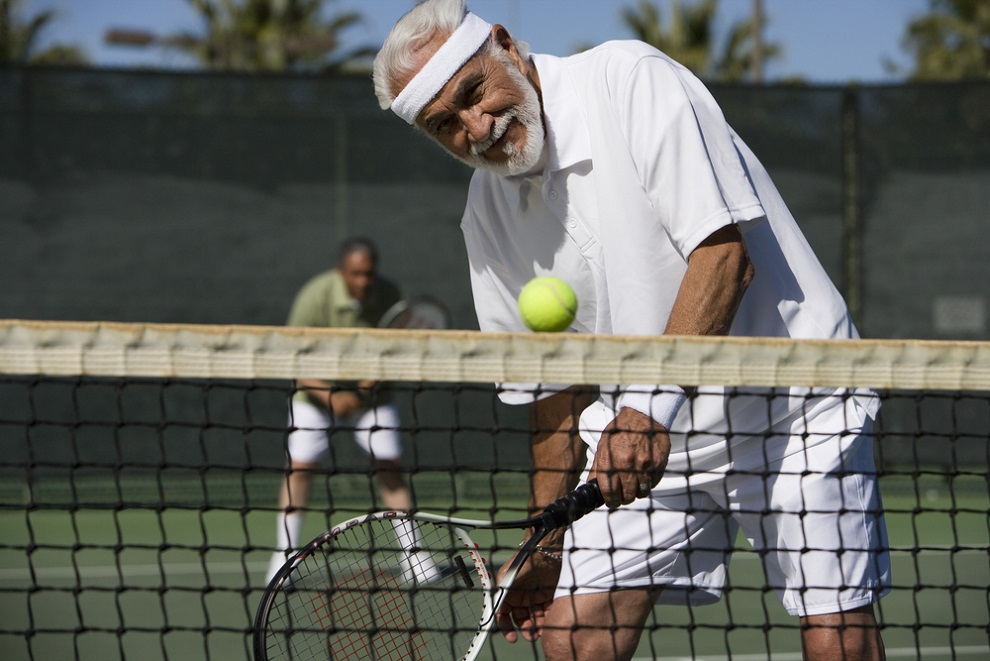Knee strengthening exercises are essential for maintaining healthy knees, overall mobility, and quality of life—a fact that becomes painfully clear when your knees start to ache. While knee pain can significantly impact daily activities, incorporating simple strength training exercises into your routine can help provide relief and improve joint function over time.
In this article, we'll explore a range of exercises designed to strengthen the muscles surrounding the knee, enhance stability, and alleviate pain, all so you can take proactive steps toward better knee health.

Understanding Knee Pain
Knee pain can arise from various factors, including injuries, overuse, arthritis, or underlying conditions such as bursitis or tendonitis. Weak muscles surrounding the knee joint can exacerbate this pain by failing to adequately support and stabilize the joint during movement.
When muscles such as the quadriceps, hamstrings, glutes, and calves are underdeveloped or imbalanced, they place added stress on the knee, which leads to reduced functionality and even more discomfort.
Incorporating targeted strengthening exercises into your workout routine can significantly alleviate knee pain by improving muscle strength, endurance, and overall joint stability. This is because strengthening these muscles helps distribute forces more evenly across the knee joint, thereby reducing stress and minimizing the risk of injury.
Even if you aren't yet experiencing knee pain, these strengthening exercises can prove helpful. Strong muscles surrounding the knee provide better support and protection and enhance overall joint integrity.
Preparing For Knee Strengthening Exercises
Before beginning any knee strengthening exercises, it's crucial to consult with a physical therapist or other healthcare professional—especially if you have a history of knee issues or injuries. They can provide you with personalized recommendations to ensure that your chosen exercises are safe and appropriate for your specific condition.
Additionally, always start with a proper warm-up to prepare your muscles, tendons, and ligaments for the upcoming activity. A dynamic warm-up—including light cardio and stretches that target the lower body—can help increase blood flow, improve flexibility, and reduce the risk of injury.
Before you begin, ensure you have the necessary equipment for your chosen exercises, such as resistance bands, weights, or stability balls. Make sure you know how to use each piece of equipment properly.
Most importantly, always listen to your body and avoid pushing through sharp or increasing pain during exercises.
Range Of Motion Exercises
Range of motion exercises go a long way in maintaining the knee joint's flexibility and mobility, preventing stiffness, and enhancing joint lubrication.
These two exercises focus on improving both knee flexion (bending) and extension (straightening) so that the knee can move through its full range of motion without discomfort or stiffness.
1. Knee Bends
Stand with your feet shoulder-width apart, then slowly bend your knees and lower your body as if you were sitting back into a chair. Keep your back straight and your knees aligned with your toes. Hold for a few seconds, then return to the starting position.
2. Leg Swings
Standing next to a sturdy object for support, swing one leg forward and backward in a controlled motion. Focus on maintaining a straight leg and engaging the muscles around the knee. Perform 10-15 swings on each leg, gradually increasing the range of motion as much as you can tolerate. Repeat on the other leg.
Incorporating these simple range of motion exercises into your daily routine not only promotes better flexibility, but lays a solid foundation for more advanced strengthening exercises.
Strengthening Exercises For The Quadriceps
Strong quads provide stability and support to the knee joint, thereby reducing the risk of injury and alleviating pain. Incorporating targeted exercises to strengthen these muscles can improve knee function and overall joint health.
1. Squats
Stand with your feet shoulder-width apart, engage your core, and slowly lower your body by bending your knees as if you were sitting back into a chair. Keep your chest lifted and your knees aligned with your toes. Finally, push through your heels to return to the starting position.
Though we recommend beginning with just squats, you can add resistance with dumbbells or a barbell as you feel stronger and more comfortable.
2. Leg Presses
Sit on a leg press machine with your back flat against the pad and your feet flat on the platform. Push through your heels to extend your legs until they are straight—but don't lock your knees. Slowly bend your knees to lower the weight back down, maintaining control throughout the movement.
3. Lunges
Stand tall with your feet hip-width apart. Take a step forward with one foot and lower your body until both knees are bent at a 90-degree angle. Keep your front knee aligned with your ankle. Push through your front heel to return to your starting position, then repeat on the other leg.
Pro Tip! When performing these exercises, focus on maintaining proper form to effectively target the quadriceps while minimizing strain on the knees. Keep your movements controlled, avoid locking your knees at the top of each repetition, and never let your knees collapse inward.
If you experience any discomfort or pain, stop the exercise and consult with a healthcare professional.
Strengthening Exercises For Hamstrings
Just like quadriceps, the hamstrings help to keep the knee stable by balancing the forces applied to the joint during movement. Strengthening these muscles not only helps alleviate knee pain, but also reduces the risk of injury by promoting better biomechanical alignment.
1. Hamstring Curls
Using a leg curl machine or resistance bands, lie face down on a machine or the floor. Bend your knees and curl your heels towards your glutes to engage your hamstrings. Slowly return to your starting position, maintaining control throughout the movement.
2. Deadlifts
Stand with your feet hip-width apart, while holding a barbell or dumbbells in front of your thighs. Bend at your hips, keeping your back straight, and lower the weight towards the floor while keeping your knees slightly bent. Engage your hamstrings and glutes to return to the standing position.
3. Bridges
Lie on your back with your knees bent and feet flat on the floor. Lift your hips towards the ceiling, then squeeze your glutes and hamstrings at the top of the movement. Control your hips as you lower them back down to the starting position.
Tips For Preventing Injury
- Start with lighter weights or resistance bands, then gradually increase the intensity as you improve your strength.
- Avoid jerky movements or using any momentum to lift your weights, as this can actually strain your muscles.
- Always warm up before starting your hamstring exercises and stretch afterwards to promote flexibility and reduce tightness.
Strengthening Exercises For The Glutes
If you're surprised that strengthening your gluteal muscles can relieve and reduce knee pain, then consider this: Strong glutes normalize hip and thigh position, thereby reducing the loading force on the knee joint and preventing the knees from caving in on each other when you're running, squatting, or landing from a jump.
1. Hip Thrusts
Start by sitting on the ground with your upper back against a bench and a barbell or weight plate across your hips. Plant your feet hip-width apart and drive through your heels to lift your hips toward the ceiling; at the top of the movement, squeeze your glutes. Finally, lower your hips back down with control.
2. Clamshells
Lie on your side with your hips and knees bent, and your feet together. Keeping your core engaged, open your top knee as far as possible while maintaining stability through your hips. Slowly return to your starting position, then repeat on the other side.
3. Lateral Band Walks
Place a resistance band around your thighs, just above your knees. Stand with your feet hip-width apart and knees slightly bent. Take small steps to the side, but be sure to maintain tension on the band and to keep your knees aligned with your toes. Repeat in the opposite direction.
Strengthening Exercises For The Calves
Strong calf muscles are important for supporting lower body stability, including knee function. They reduce the strain on knees by absorbing shock during movement and contributing to proper alignment.
1. Calf Raises
Stand with your feet hip-width apart, then rise onto the balls of your feet as high as you can go, lifting your heels off the ground. Hold for a moment at the top, then lower back down slowly.
2. Seated Calf Raises
Sit on a chair or bench with your feet flat on the ground and your knees bent at a 90-degree angle. Place a weight on your thighs for resistance, then lift your heels off the ground by pushing through the balls of your feet. Lower back down slowly.
3. Calf Stretches
Stand facing a wall with one foot in front of the other, but be sure to keep both feet on the ground. Lean forward and press your hands against the wall until you feel a stretch in the calf of your back leg. Hold for 20-30 seconds, then switch calves.
Tips For Safe And Effective Exercise
Ensuring safety and effectiveness in your knee-strengthening routine is hugely important. After all, you won't do yourself any favors if you injure another part of your body while trying to relieve your knee pain. And if you need some tips on returning to the gym after an injury, read more here!
Here are some essential tips to keep in mind:
1. Listen To Your Body
Pay attention to any signs of discomfort or pain during exercise. If you experience sharp or increasing pain, stop what you're doing immediately and reassess. Correct your position or adjust the intensity, range of motion, or exercise selection as needed to accommodate your body's limitations and avoid overexertion.
2. Progress Gradually
Though you're surely eager to relieve pain as quickly as possible, don't rush things. Start with exercises that match your current fitness level and gradually increase the intensity, duration, or resistance over time. This allows your muscles and joints to adapt and strengthen safely.
3. Avoid Any Exercises That Exacerbate Pain
If certain exercises consistently cause discomfort or aggravate knee pain, then refrain from performing them. Instead, choose alternate exercises that target the same muscle groups, but that don't exacerbate existing issues.

Lifestyle Factors For Healthy Knees
In addition to incorporating knee-strengthening exercises into your daily routine, certain lifestyle factors also play an important role in promoting overall knee health and preventing further discomfort.
Here are some tips to consider.
1. Maintain A Healthy Weight
Excess body weight can put added strain on your knees, making any pain worse and increasing the risk of injury. By maintaining a healthy weight through a balanced diet and regular exercise, you can reduce the load on your knees and improve joint function.
2. Wear Proper Footwear and Supportive Gear
Wearing appropriate footwear with adequate support and cushioning can help alleviate stress on your knees during physical activity. Invest in shoes specifically designed for your chosen activities, and consider using supportive gear such as knee braces or orthotic inserts.
3. Incorporate Low-Impact Activities
High-impact activities like running or jumping can place significant stress on your knees—especially if you're already experiencing knee pain.
Consider incorporating more low-impact exercises such as swimming, cycling, an elliptical machine, or some of the simple exercises outlined above. These types of activities reduce strain on the joints while building up surrounding muscles and maintaining cardiovascular fitness.
4. Prioritize Rest And Recovery
Giving your body sufficient time to rest and recover between workouts is vital for preventing overuse injuries and allowing muscles and joints to repair and strengthen. Listen to your body's signals for fatigue or discomfort, and adjust your exercise routine accordingly.
Frequently Asked Questions
What is the best exercise for knee pain?
The best exercise for knee pain often depends on the underlying cause of the pain. However, low-impact exercises like swimming, cycling, and walking, plus easy exercises such as calf raises, lunges, and squats are generally recommended because they help strengthen the muscles surrounding the knee without putting excessive stress on the joint itself.
Is it okay to stretch when you have knee pain?
Stretching can be beneficial for knee pain if done correctly and with caution. Gentle stretching of the muscles surrounding the knee—especially the quadriceps, hamstrings, and calves—can help improve flexibility and alleviate tension.
But it's important to avoid overstretching or pushing through sharp pain, as this can exacerbate the problem.
What's the fastest way to relieve knee pain?
The fastest ways to relieve knee pain may vary depending on the cause and severity of the pain. Some immediate relief measures include resting the knee, applying ice packs to reduce inflammation, elevating the leg to reduce swelling, and taking over-the-counter pain medication such as ibuprofen or acetaminophen. When you do light exercise, it will also be helpful to use assistive devices such as knee braces or wraps to alleviate discomfort and provide stability.
Final Thoughts
By adopting healthy lifestyle habits in conjunction with a comprehensive knee-strengthening routine, you can support overall joint health and reduce the likelihood of knee pain and injury in the long term. Remember: Consistency and patience are key, and always consult with your healthcare professional if you have any concerns or persistent symptoms.
If you need a little help with that extra boost, why not give Male Excel a call? Our personalized approach to men's health ensures you achieve your goals and unleash your true potential. Say goodbye to mood swings and fatigue and hello to vitality and focus with our testosterone treatments.
Take action and transform your life with Male Excel.

Find out if TRT Can Help You
TRT from Male Excel





